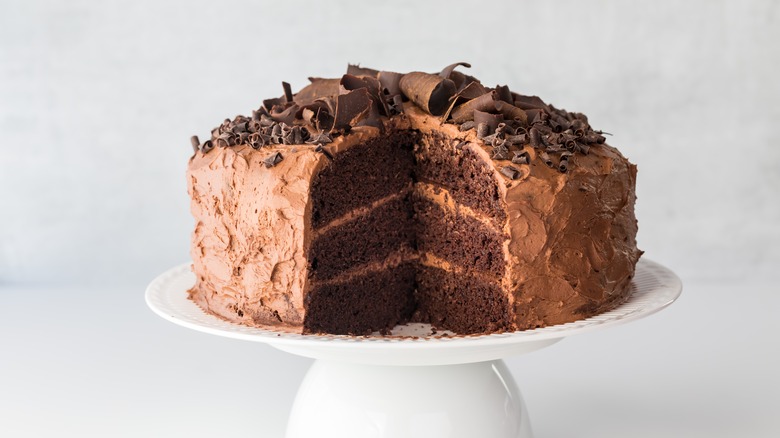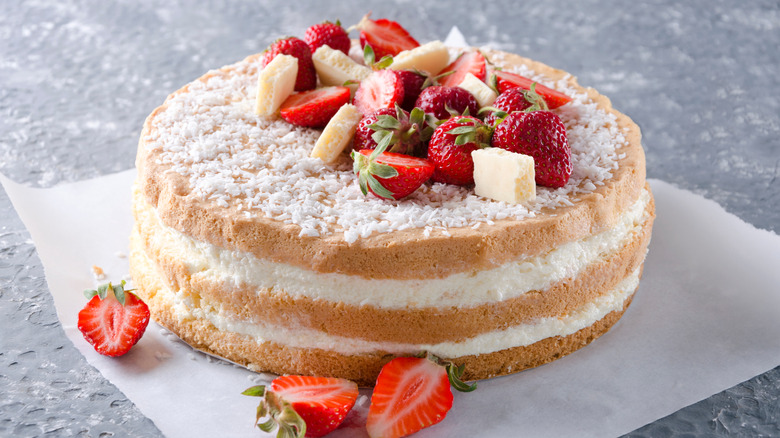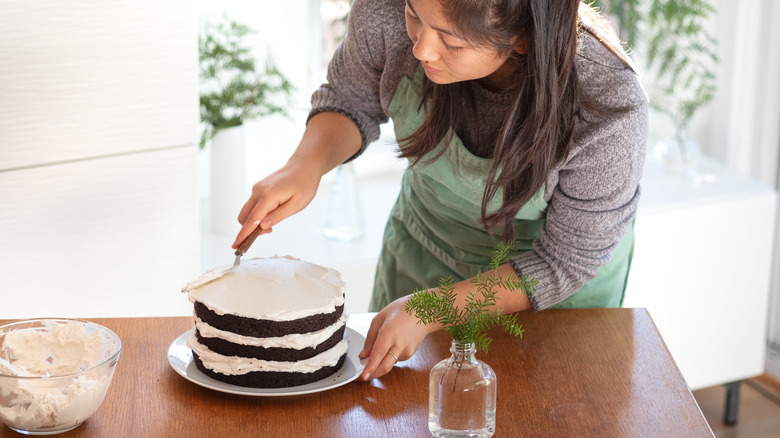Cake Too Dry? Add Some Layers And Thank Us Later
A dry cake has happened to many a baker before. Perhaps the recipe they were following had too much flour, which absorbed all the moisture in the cake. Maybe the oven was a little hot, literally drying it out. Suppose they were interrupted and they left it baking for too long, again, drying it out. Whatever the reason, it's never a good thing to dump the cake out into the trash. The fix for dry cake is an easy and tasty one: Turn it into a layer cake.
By definition, layer cakes are cakes that include layers of sweet filling in between the stacked cake. These fillings are usually some type of frosting like buttercream or ganache, or even fruit preserves and whipped cream — and it's up to the baker to get creative here. Frosting and fruit preserves are moist by nature thanks to their composition of fat, sugar, and liquid. By sandwiching these between layers of cake, their moisture then seeps into the cake. This is particularly useful for cakes that already are a little on the drier side to begin with, like foam cakes.
What makes layer cakes more moist?
Could you then just slap a little frosting or jam on top of a dry cake and call it a day? Well, yes, but the moisture would then not be very evenly distributed, and you will likely get a mouthful of distinct components of cream and dry cake. What you need to do is to cut your dry cake horizontally into at least two separate cake layers, and insert filling in between them to create a layer cake. By creating even just two layers of cake, you'll be distributing the filling more evenly to saturate the dry cake, making the overall cake more moist.
Cream- or fruit-based fillings work well to impart moisture. Whipped cream, various types of buttercream, fruit jams, or even sliced fresh fruit would help saturate the layers of dry cake. Even curds and puddings can be used to moisten dry cake layers — take a cue from this pudding tip for poke cakes. Common sense rules apply here: The more liquid the filling contains, the more moisture it can impart to the cake. Many versions of layer cakes even include syrups that are brushed onto the dry cake layers, adding even more moisture and texture.
Layer cake ideas
What cake and filling combinations would work? Chocolate plays well with other flavors, whether it's chocolate cake with peanut butter frosting, or chocolate frosting on a yellow cake. White cakes are blank canvases just waiting to be zhuzhed up with fruity fillings like strawberry buttercream or citrus curd.
Consider famous layer cakes like Black Forest cake and Victoria sponge — cakes that are known to be deliciously moist. Black Forest makes use of brandy-infused syrup to soak the cake layers before adding cherry compote. Victoria sponge cakes rely on strawberry jam and whipped cream instead for moisture and flavor. Use these cakes as inspiration points to create your own layer cake combinations, and who knows, you might create a new family favorite!
That said, layer cakes are not a slapdash endeavor. You still need to exercise care to make sure they turn out well, especially so the layers don't slide off each other. Some of the more structural mistakes when building layer cakes can be avoided: Remember to cut the cake as evenly as possible when dividing it into layers — preferably using a long and flat serrated knife. Check after adding each layer and filling to make sure the cake layers are aligned properly. Too much or unevenly applied filling can also cause your layer cake to lean. If all of this sounds too fussy, there's another solution: Just turn your cake into cake pops.


